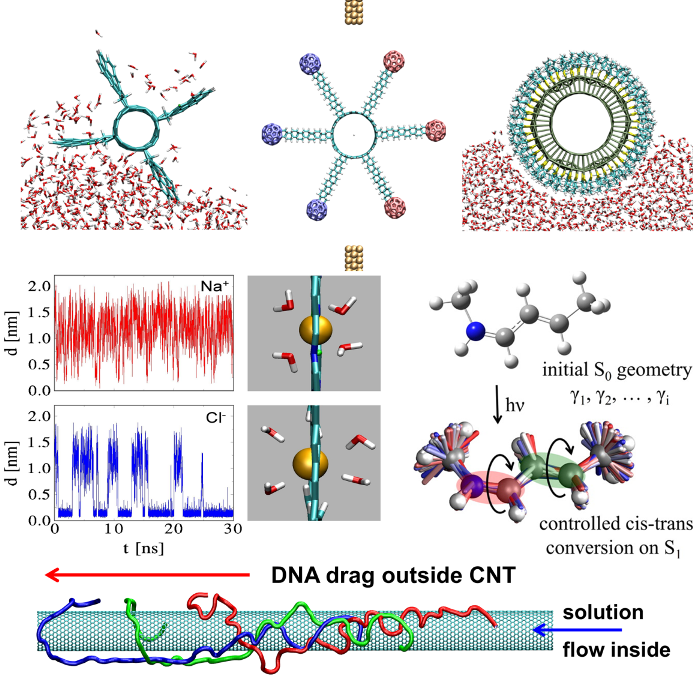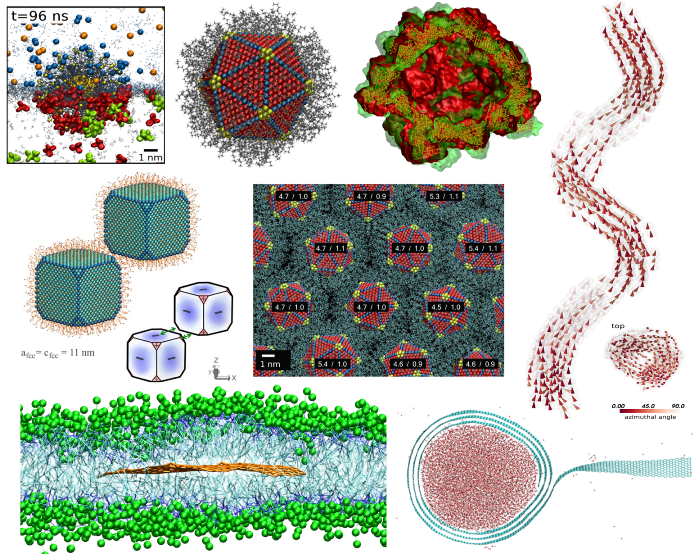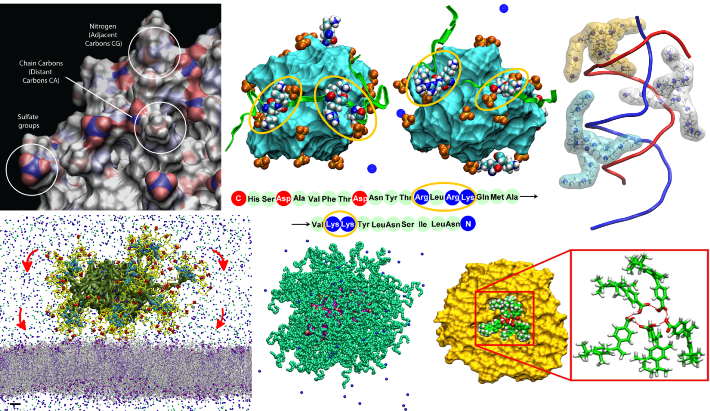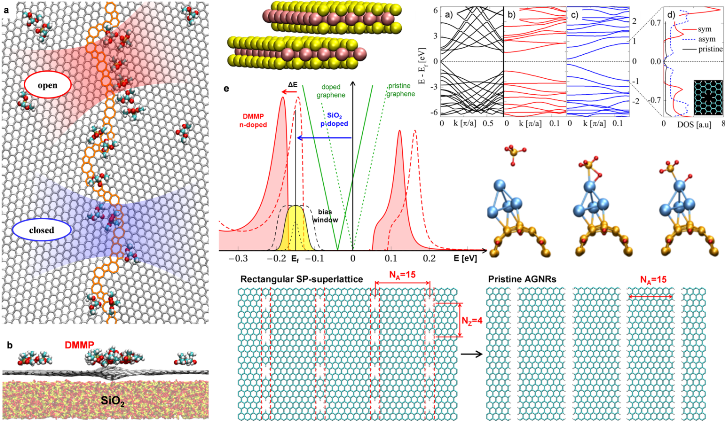Research in our theory group is devoted to modeling of realistic nanosystems
in close collaboration with experimentalists. We use quantum and classical
(atomistic and coarse-grained) molecular dynamics (MD) simulations, Monte Carlo
and other techniques to model molecular and nanoparticle self-assembly, storage,
transport, delivery, and (bio)-activity. We also study electronic structures and
transport properties of complex nanosystems. The calculations are performed on
our multiprocessor and GPU clusters and on national supercomputers.
Molecular Transport and Machinery:
Historically, the group was involved in studies of molecular transport phenomena
in nanotubes and modified graphene. We have been particularly active in nanofluidic
studies related to molecular drag around nanoscale surfaces and molecular passage
through ultrasmall nanopores. We pioneered the studies of nanopores in graphene,
which are currently extensively studied experimentally. The group was also active
in design of nanoscale machinery, such as propellers, motors, and rotors, which was
extended to optically driven molecular motors (chromophores).

Figure 1 Selected pictures related to molecular transport and machinery studies
Self-assembly of nanoscale systems:
Another direction of our research are the studies of self-assembly of molecular and nanoscale components. We investigate the structures and properties of such systems. Our studies have either purely material origins (superlattices, clusters) or they address biocompatible systems (molecular storage, delivery, passage, activation with micelles and nanoparticles). Most of the studies are performed in collaborations with many domestic and international experimental groups.
a) Material systems
We study the spontaneous and guided assembly of colloidal nanoparticles and nanostructures. We use precise atomistic simulations in combination with missing mean-field forces (bulk vdW coupling) to elucidate the conditions necessary for the formation of unique structures observed in experiments. Typically, the colloidal systems are stabilized by a delicate competition (balance) of many different forces associated with different types of coupling, such as van der Waals, Coulombic, Zeeman, dipole-dipole (electric or magnetic), magneto-anisotropic, solvation, etc. Besides the forces associated with the particles themselves and the external fields, a large role is often played by the chemistry of the nanoparticle ligands, solvent, pH, ionic strength, and temperature.

Figure 2 Selected pictures related to self-assembly of material systems
We have studied the self-assembly of nanoparticles of different compositions, sizes, shapes, ligands, and in different solvents, leading to superlattices of different lattice types or clusters of specific organizations. Some of the recent systems necessitated the development of Monte Carlo codes to examine their stabilization (superparamagnetic nanoparticles in external fields). In other cases, the nanoscale components are planar (graphene flakes) and they self-assemble in many different ways either on their own or with the assistance of other nanostructures. We investigate the stability of the systems formed, their mechanical and other properties.
b) Bio-related systems
In recent years, many biocompatible and bioactive nanosystems have been prepared. In collaboration with several experimental groups, we design micelles for nanomedicines, based on their stability, ability to penetrate cells, targeting potential, molecular storage capability, etc. The micelles are formed of linear or branched (dendron-based) copolymers that are amphiphilic by design. We examine how the character of their hydrophobic tail (micelle core), the dendron type (branching), PEG corona chains (length), and types of end groups and targeting groups affect the properties of nanomedicines formed. Other delivery methods for nucleotides are also studied (wrapping polyelectrolytes). We also study the bioactivity (immune-response) of ligated nanoparticles, in dependence on the type of their end groups.

Figure 3 Selected pictures related to self-assembly of bio-related systems
Electronic structure and transport in nanoscale systems:
Finally, we also study quantum mechanical properties of nanoscale systems. These studies are related to previous research activities of the PI in the area of electron transport, quantum optics, and coherent control. In the past, we have designed numerous carbon-metal nanostructures and examined through first principle calculations their electronic properties, in particular, catalytic activity. We have also studied the electronic structures of other nanoscale materials, such as porous nanocarbons with the goal to elucidate their potential in electronics and molecular sensing.

Figure 4 Selected pictures related to electronic structure and transport studies
In the last 1-2 years, we have extensively collaborated with experimentalists on examination of the catalytic activity of MoS2 (CO2 reduction) in ionic liquids, and on the molecular sensing on graphene grain boundaries deposited on SiO2 substrate. These complex studies necessitate using hybrid computational methods, where the material systems in solutions, on substrates, or in the presence of adsorbed molecules are first stabilized and equilibrated by classical and quantum molecular dynamics simulations. Then the electronic structures of these systems are calculated under different conditions. Finally, electron transport is studied in these systems using advanced computational methods. We have also participated in studies related to energy storage systems, such as batteries.